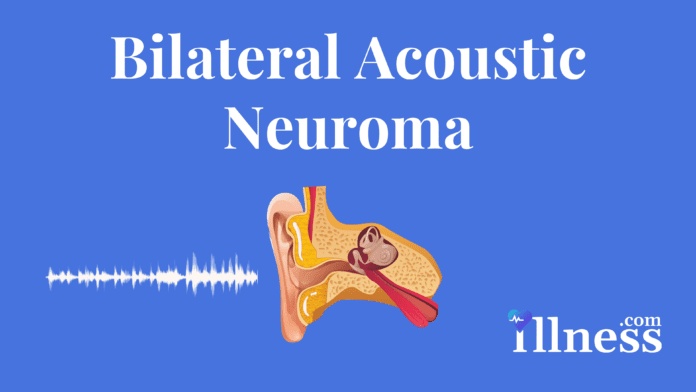Overview
An acoustic neuroma is a slow-growing tumor of the nerve that connects the ear to the brain. This nerve is called the vestibular cochlear nerve. It is behind the ear, right under the brain.
An acoustic neuroma is benign. This means that it does not spread to other parts of the body. However, it can damage several important nerves as it grows.
Commonly Associated With
Vestibular schwannoma; Tumor – acoustic; Cerebellopontine angle tumor; Angle tumor; Hearing loss – acoustic; Tinnitus – acoustic
Cause
Acoustic neuromas have been linked with the genetic disorder neurofibromatosis type 2 (NF2).
Acoustic neuromas are uncommon.
Symptoms
The symptoms vary, based on the size and location of the tumor. Because the tumor grows so slowly, symptoms most often start after age 30.
Common symptoms include:
- Abnormal feeling of movement (vertigo)
- Hearing loss in the affected ear makes it hard to hear conversations
- Ringing (tinnitus) in the affected ear
- Less common symptoms include:
- Difficulty understanding speech
- Dizziness
- Headache
- Loss of balance
- Numbness in the face or one ear
- Pain in the face or one ear
- Weakness of the face or facial asymmetry
Exams & Tests
The health care provider may suspect an acoustic neuroma based on your medical history, an exam of your nervous system, or tests.
Often, the physical exam is normal when the tumor is diagnosed. Sometimes, the following signs may be present:
- Decreased feeling on one side of the face
- Drooping on one side of the face
- Unsteady walk
The most useful test to identify an acoustic neuroma is an MRI of the brain. Other tests to diagnose the tumor and tell it apart from other causes of dizziness or vertigo include:
- Hearing test
- Test of equilibrium and balance (electronystagmography)
- Test of hearing and brainstem function (brainstem auditory evoked response)
Treatment
Treatment depends on the size and location of the tumor, your age, and your overall health. You and your provider must decide whether to watch the tumor without treatment, use radiation to stop it from growing or try to remove it.
Many acoustic neuromas are small and grow very slowly. Small tumors with few or no symptoms may be watched for changes, especially in older people. Regular MRI scans will be done.
If not treated, some acoustic neuromas can:
- Damage the nerves involved in hearing and balance
- Place pressure on nearby brain tissue
- Harm the nerves responsible for movement and feeling in the face
- Lead to a buildup of fluid (hydrocephalus) in the brain (with very large tumors)
Removing an acoustic neuroma is more commonly done for:
- Larger tumors
- Tumors that are causing symptoms
- Tumors that are growing quickly
- Tumors that are pressing on the brain
- Surgery or a type of radiation treatment is done to remove the tumor and prevent other nerve damage. Depending on the type of surgery performed, hearing can sometimes be preserved.
- The surgical technique to remove an acoustic neuroma is called microsurgery. A special microscope and small, precise instruments are used. This technique offers a higher chance of cure.
- Stereotactic radiosurgery focuses high-powered x-rays on a small area. It is a form of radiation therapy, not a surgical procedure. It may be used to slow down or stop the growth of tumors that are hard to remove with surgery. It may also be done to treat people who are unable to have surgery, such as older adults or people who are very sick.
- Removing an acoustic neuroma can damage nerves. This may cause loss of hearing or weakness in the face muscles. This damage is more likely to occur when the tumor is large.
Source
Courtesy of MedlinePlus from the National Library of Medicine



